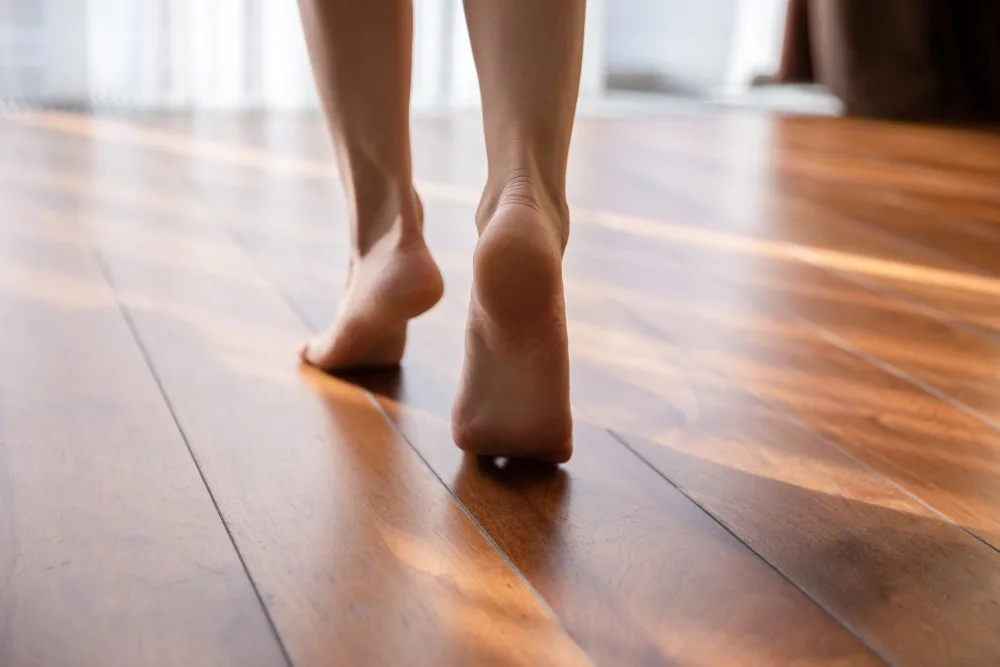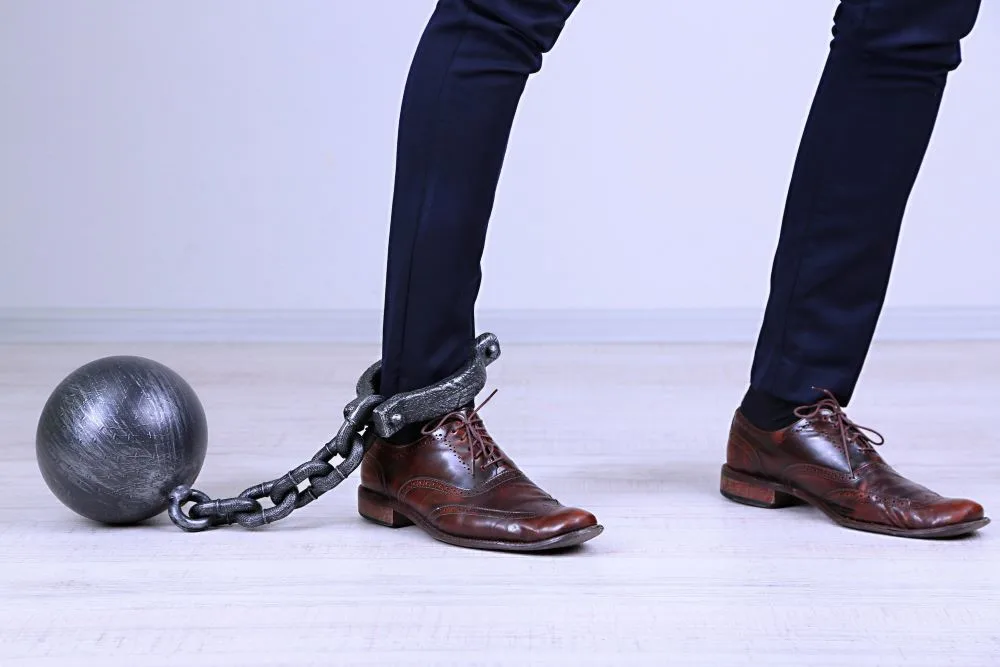If your neighbors have complained that you are stepping too loudly above them and making too much noise, you are going to need to come up with some ideas on how to improve the situation. Or if your neighbor is the one making the noise, send them this article as a little nudge—just kidding. Approaching your upstairs neighbor about them walking loudly needs to be handled tactfully.
On your part, walking quietly doesn’t need to be complicated, and there are many useful methods to reduce the sound of feet hitting the floor. However, I do want to point out here that you are not required to adjust the way you walk just because it disturbs your neighbor. The steps you take are a courtesy and should be received with gratitude, not entitlement.

To ensure that your walking is as quiet as befits apartment living, you can take off and put on your shoes at the door, wear thick socks, walk toe to heel, take shorter strides, and avoid shuffling. You can also fix squeaking boards and install carpets or rugs.
Take off/Put On Your Shoes at the Door
One of the simplest options for keeping your steps quiet is to take off your shoes. Many shoes, especially those that are heavy and have thick soles can be very noisy as you step through the house. This may be disruptive to your downstairs neighbors if you have thin flooring and they could start to complain, particularly if you combine loud walking with squeaky floors!
If you remove your shoes at the door, you will be able to tread much softer throughout the house and produce less noise.
This method has the additional benefit of keeping floors clean. During the winter, keeping your shoes at the door prevents mud and snow from being tracked in. This can also be beneficial during rainy seasons.
Wear Thick Socks or Soft-Sole Slippers
Another straightforward method involves wearing thick socks or slippers to cushion each step and muffle the sound. Thick fabrics such as cotton, plush microfibers, or wool, will absorb some of the noise of each footstep you take. Moccasins are a great way to go.
- TIMELESS STYLE: Minnetonka boasts a rich heritage that includes a tradition of careful craftsmanship since 1946, delivering excellent quality footwear using only the finest materials to provide...
- COZY SHOE FIT: The Kilty suede moccasins are made to stretch to the contours of your feet and wear pattern over time, ensuring that each pair of our softsole moccasin fit snugly and getting more...
- CONVENIENT SIZING: Each Minnetonka Kilty softsole run full size large; Refer to the convenient Size Chart icon to ensure correct sizing before purchasing; If your feet are different sizes, make sure...
- MORE THAN JUST REGULAR FOOTWEAR: Our popular Kilty moccasins in the original soft sole style are the ultimate in comfortable shoes; Crafted by hand, these moccasins have an almost-barefoot feel with a...
- PERSONALIZED FIT: The suede leather uppers of the lace up moccasins adapt to your feet, giving it a more personalized fit that will help you walk comfortably on a daily basis
- DISTINCTIVE STYLE: Designed as unlined and with an adjustable rawhide leather laces and moc toes give these men's suede moccasin slippers lends a very relaxed vibe that are perfect for any casual days...
- ALL DAY COMFORT: These men's moccasin slippers are made with padded footbeds and a distinctive softsole to ensure each foot fall is given the right cushioning
- SIZING: Our men's suede moccasin slippers run true to size; Remember that if you have different foot sizes, choose the larger one to get the most accurate fit
Last update on 2024-03-29 / Affiliate links / Images from Amazon Product Advertising API
It could be as easy as keeping a pair of squishy bunny slippers (amazon link) next to your door to slip into when you take your shoes off. Otherwise, you could have a pair you use only on certain areas of the flooring that you know are squeaky or aren’t carpeted.
Certain socks that you are already wearing might be effective for this purpose, or you could layer multiple pairs of socks on top of each other if you don’t have many thick pairs.
This trick also has the benefit of keeping your feet warm in case your floors are cold.
Walk Toe to Heel
While you may have been told to tiptoe when you needed to walk quietly in the past, this has proven not to be the quietest walking method. Instead, there is a different method that you should use, involving shifting your weight.
When you tiptoe, you are exerting all your weight on the ball of your feet with every step, which can be just as loud as putting the weight on your heel. However, if you shift your weight from the front to the back of your foot with each step, this will reduce the overall sound you produce.

Stepping toe to heel will muffle the sound of each step as the entire force of your footstep is not directed at just one area of the foot. Instead, the force is lessened as the ball of the foot softens the initial blow and then the heel of the foot takes the rest of the force.
Take Shorter Strides
You may not be considering how long or short your strides are when thinking about how loud your footfalls are. However, when you take long strides, you are pushing harder onto the floor with each step. Shorter steps mean that you are stepping lighter and will produce less sound.
The reason this happens is because taking long strides makes you lean forward and almost fall onto your front foot. As you catch your fall, it may create a louder noise.
Taking shorter strides will also help prevent you from tripping and falling, since long strides are often used in tandem with faster walking, and this can be a recipe for a great fall if you’re not careful.
Don’t Shuffle
Noisy footfalls do not always come from loud booming footsteps. Sometimes the motion of your footsteps can produce a different kind of disruptive sound.
If you are the type of person who doesn’t pick up their feet while walking, it can produce a shuffling noise against your floor. This noise can be just as disruptive to downstairs neighbors as heavy footfalls.

You may need to consistently remind yourself to pick up your feet if you are not in the habit of doing so. You can also wear lighter shoes, shoes that sit properly on your feet, or no shoes at all, which will encourage you to pick up your feet rather than drag them along the floor.
Shuffling your feet can be a large trip hazard, so picking up your feet is a good habit to form all around.
Learn Where the Creaking Boards Are (Fix Them)
There may be certain boards in your apartment that produce a squeak every time you step on them. More than likely, these boards will be in areas where you frequently step, so you will notice where they are.
Boards that are frequently stepped on are more likely to come loose from their fasteners over time. The movement of the subfloor is what produces the squeaking noise.
Take a mental note the next time you hear that one squeaky board and take the steps needed to fix it. There are a variety of methods for lessening squeaking, which can include screwing the board down more securely or even using a glue-like adhesive to secure the subfloor.
For rentals, you might not be able to use these more invasive methods, but there are still ways to fix squeaky floors in a rental.
Investigating and repairing squeaky floors may save you a lot of expensive repairs and even some injuries because some squeaks are actually a sign of a serious problem.
Invest in Thick Carpeting or Rugs
In the same way that thick socks and slippers can cushion the noise of your footsteps, carpeting can also be used to soften the sound.
There are plenty of places within the home that can benefit from adding carpeting or rugs. These are places where you spend a lot of time hanging out or places where you might frequently walk barefoot, such as beneath your bed or in the bathroom.
Adding rugs to areas where you frequently walk and would otherwise just have tile, linoleum, or hardwood flooring that could be noisier, will reduce noise and make these materials more comfortable to walk on.
You can still enjoy the look of your hardwood flooring in areas where you frequent less, such as the edges of the living room or bedroom.
If your downstairs neighbor has been complaining about the loudness of your footfalls and you cannot afford a rug or carpeting, they might be willing to pay or at least go halvies. After all, you don’t have to change how you walk just because your downstairs neighbor believes that you walk too loudly.





